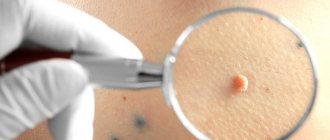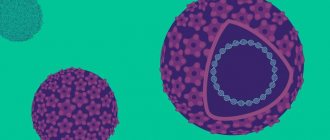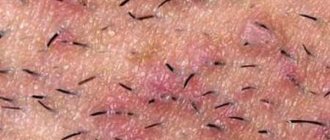Symptoms
Acne rashes on the head can have different appearances depending on the stage of development.
- Closed comedones are white tubercles without escaping the contents.
- Open comedones are “blackheads”.
- Papules (nodules) are hard bumps on the skin that are red or purple in color.
- Pustules are purulent tubercles.
Small pustules dry out without causing skin changes. Large ones - after healing they leave scars.
Acne on the scalp is almost always accompanied by dandruff and very often itching. Pimples can be painful, interfere with normal hair care, and create not only an aesthetic problem, but also cause physical discomfort.
Message sent!
Hair loss
Thyrotoxicosis
Menopause
Climax
Syphilis
HIV
21260 05 August
IMPORTANT!
The information in this section cannot be used for self-diagnosis and self-treatment.
In case of pain or other exacerbation of the disease, diagnostic tests should be prescribed only by the attending physician. To make a diagnosis and properly prescribe treatment, you should contact your doctor. Hair loss: causes of occurrence, what diseases it occurs with, diagnosis and treatment methods.
Definition
Normally, a person loses approximately 100 hairs every day; an increase in this number may indicate pathological processes in the body. The patient notices that a large amount of hair remains on the comb, on bed linen, towels, in the bathroom drain and on household items.
About 0.1% of the entire population of the planet has experienced increased hair loss at least once.
Hair density varies from person to person and in different areas of the body. It depends on age, gender, race, etc. The total number of hairs on the head of blondes is 140 thousand, for brown-haired people - 109 thousand, for brunettes - 102 thousand, for redheads - 88 thousand.
All hair does not grow at the same time, but goes through 3 main growth phases: anagen, catagen and telogen. Anagen is the phase of active hair growth - its duration ranges from 2 to 5 years. During the day, hair lengthens by an average of 0.1–0.4 mm, and women's hair grows faster than men's. During the catagen phase, growth slows down and lasts from 4 to 6 weeks. During the telogen phase, hair growth stops, its life cycle ends and it falls out. This period lasts 2–3 months and during this time conditions are created for the start of a new anagen phase.
Types of hair loss
Androgenetic, or androgenetic alopecia, is the most common form of hair loss, affecting up to 80% of men and 50% of women.
Diffuse alopecia is more common in women.
Psychosomatic or nervous alopecia.
Alopecia areata, which is currently considered an autoimmune process.
Cicatricial or infectious alopecia.
Age-related alopecia.
Seasonal alopecia.
Possible causes of hair loss
Pathology of hair growth (partial loss, total baldness, hirsutism, hypertrichosis) occurs due to disturbances in the hair cycle. The most common cases of hair loss are the premature end of the anagen phase and the early start of the catagen phase.
During puberty, when hormonal changes occur in the body, there is increased sebum production and excessive hair loss. Upon completion of puberty, most people experience normal processes.
The capillaries of the papilla in males who are genetically predisposed to baldness have increased sensitivity to male sex hormones. With an increase in androgen content during puberty, persistent spasm of the blood vessels in the scalp papillae occurs and, as a result, hair loss. On the contrary, on other parts of the body, including the face, such men experience abundant hair growth, which is also explained by the action of androgens.
Despite the increased secretion of estrogen during pregnancy, many women complain of excess hair loss, especially in the 2nd and 3rd trimesters. This is due to the fact that at this time almost all the nutrients entering the woman’s body are spent on fetal growth. Postpartum hair loss is caused by an increase in the amount of hair in the telogen phase.
Typically, a woman's hair growth cycles resume 4-6 months after giving birth.
Increased hair loss can be caused by stress. In patients with disturbances in periods of sleep and wakefulness, memory loss, and obsessive states, various changes in the biopotentials of the brain are observed, which can lead to disruption of the trophism of the hair follicle.
Exogenous factors (insolation, dry air, use of a hot hair dryer, aggressive shampoos, dyes) have a negative impact on the condition of the hair. This occurs due to disruption of the “tile-like” arrangement of hair scales, leading to splitting of the hair shaft and increased fragility.
Taking certain medications (non-steroidal anti-inflammatory drugs, anticoagulants, thyreostatics, antidepressants, cytostatics, beta-blockers, alpha interferon drugs, anticonvulsants, antiparkinsonian, anthelmintic, antiherpetic, antiviral, antibacterial drugs, neuroleptics, oral contraceptives, etc.) can also lead to increased hair loss.
80% of cancer patients taking cytotoxic drugs experience hair loss within 10 days of starting treatment.
Infectious, autoimmune, systemic diseases, endocrine pathologies also affect excessive hair loss.
As a person ages, hair growth on the scalp may be stable, but the anagen phase tends to decrease. Hair becomes thinner and brittle. Hair loss is more common in women over 50 years of age and is diffuse in nature.
Diseases leading to excessive hair loss
- Diseases of the thyroid gland, hypothalamic-pituitary system, ovaries, adrenal glands, etc.
- Autoimmune diseases (nodular goiter, idiopathic hypoparathyroidism, Hashimoto's thyroiditis).
- Dermatological diseases (seborrhea, psoriasis, eczema, etc.).
- Diseases of internal organs and systems (gastritis, colitis, kidney and liver diseases).
- Vitamin deficiencies.
- Chronic infections (tonsillitis, sinusitis, sinusitis).
- Cytomegalovirus infection.
- Syphilis.
- Tuberculosis.
- Immunodeficiency states.
Which doctors should you contact if you have excessive hair loss?
If you have excessive hair loss, you should consult a dermatologist or trichologist. In the future, a consultation with a phthisiatrician or rheumatologist may be recommended.
Diagnosis and examinations for excessive hair loss
To find out the cause of hair loss, the doctor may prescribe a set of laboratory and instrumental examination methods:
- clinical blood test with determination of hemoglobin concentration, number of erythrocytes, leukocytes and platelets, hematocrit and erythrocyte indices (MCV, RDW, MCH, MCHC), leukoformula and ESR (with microscopy of a blood smear in the presence of pathological changes);
Exogenous causes of subcutaneous acne on the head*
- Improper hair care. Washing your hair too often or infrequently can cause a rash.
- Sleep on pillows made from synthetic materials. The scalp actively sweats, and synthetics do not allow it to “breathe.”
- Using too hard or overly chlorinated water when washing your hair can lead to dry skin, which causes the sebaceous glands to secrete more sebum, causing the appearance of comedones.
- The wrong choice of shampoo can also cause a rash if it contains components that act as allergens. Poorly washed balm often provokes a rash and causes peeling of the skin.
- Not wearing a hat in winter can cause hair loss and acne.
- Taking hormonal drugs and anabolic steroids.
- Lack of minerals, vitamins, excess glucose and fats in the diet negatively affect the entire body.
Acne in women and men: are there any differences?
Before getting rid of acne, it is worth understanding whether there is a difference in their formation and treatment.
- The male dermis is much thicker and oilier, and therefore can be several times more susceptible to various inflammatory processes. In the body, androgens, that is, hormones of the stronger sex, are responsible for the functioning of the glands.
- In the female version, the culprit is most often an imbalance of substances such as progestogens and estrogens. Even after the body goes through puberty, there remains a risk of hormonal imbalances due to the presence of menstruation, pregnancy and lactation.
When the defect is caused by other reasons, for example, poor quality care or gastrointestinal diseases, then no difference by gender is observed. The only provoking factor is naturally oilier skin and sometimes various concomitant diseases.
Treatment with folk remedies
Some folk remedies are quite effective in eliminating such manifestations. However, they are used only after the doctor’s approval, and in no case replace the main treatment with such methods.
- Tar soap . Dries out acne and eliminates too much oily skin. The soap is applied to the scalp and washed off after a while.
- Yeast mask . To prepare such a mask, you should mix several ingredients: 2 tsp. dry yeast, 1 tsp. lemon juice, orange, grated carrots. The mass should be heated in a water bath and applied to the scalp for 20 minutes.
- Mask with milk . Combine 100 ml milk and 2 tbsp. l. dry yeast and stir until smooth. Apply to the scalp for 20 minutes, then rinse with warm water.
- Calendula . Pharmacy tincture of calendula (2 tablespoons) should be added to a glass of water. Mix and use a cotton pad to wipe the scalp with this solution.
- Tea tree oil . It is recommended to add a few drops of the product to shampoo.
- Henna . The henna package should be poured into a container and filled with a glass of water at a temperature of about 70 degrees. After a few hours, add a chicken egg to the mixture and mix thoroughly. Apply to scalp for 30 minutes.
- Apple vinegar . Mix equal parts of vinegar with water and use this product to rinse your hair after washing.
- Aloe juice . The juice from the leaves of the plant should be applied to the skin and left for about half an hour. After this, you need to wash your hair thoroughly.
- Honey and cinnamon . Mix 2 tbsp. l. honey and 1 tsp. cinnamon, mix everything thoroughly. Leave the mask on the skin for 30 minutes, then wash your hair.
Prevention
In order not to worry about how to solve the problem, you can simply prevent it by taking various preventive measures in time:
- Proper deep cleansing.
- Timely care.
- Selecting suitable cosmetics.
- Regular checks for internal problems and diseases.
- Maintaining hygiene.
- Proper diet and balanced nutrition.
- Moderate physical activity.
- Rinse off decorative cosmetics at night.
- Visiting a dermatologist and cosmetologist.
Let's sum it up
Thus, it became completely clear why a lot of acne appears on the forehead of girls and women, children and teenagers, boys and men, because the reasons often lie on the surface. By providing the skin with competent, high-quality, and most importantly, timely care, you can most often get rid of the problem or even prevent it using good, proven and reliable means. However, sometimes this is associated with the development of any diseases, then you definitely won’t be able to do without contacting a specialist.
Diet
Diet for acne
- Efficacy: therapeutic effect after 21-30 days
- Terms: 6-8 months
- Cost of products: 1700-1800 rubles. in Week
The healthiest diet should be ensured, and the food should fully satisfy the body's need for essential vitamins and minerals. To normalize the condition of the skin, it is important to provide sufficient amounts of the following vitamins:
- Vitamin C - found in citrus fruits, black currants, sauerkraut, and onions.
- B vitamins – sea fish, tomatoes, bananas, nuts, mushrooms, cabbage, buckwheat.
- Vitamin E – milk, nuts, fish.
- Vitamin A – carrots, eggs, apricot, parsley.
- Vitamin D – butter, cod liver, seaweed, eggs.
- Vitamin K - chicken, eggs, fish.
Also, the diet must include porridge, dairy products, dried fruits, fresh vegetables and fruits.
The amount of fatty foods, alcohol, salty foods, confectionery products, and smoked foods should be minimized. It is not recommended to drink a lot of coffee and strong tea.
Rules and tips
If the situation has not yet become critical and it seems that you can cope with it yourself, it makes sense to learn a few simple recommendations from real professionals:
- We must not forget about hygiene for a second; the skin should always remain clean and well-groomed. But this does not guarantee getting rid of acne. To protect yourself as much as possible, you should thoroughly wash all sponges, makeup brushes and other accessories after each use. If you see that they are not washed, just replace them with new ones; there is no need to skimp on your health. About once a week you need to change your pillowcases, and replace your regular towel with disposable paper ones.
- An inspection of your cosmetic bag should be carried out every six months, or better yet, every three months. Everything is sorted out, shelf life, appearance, smell, consistency are assessed. At the slightest suspicion, it is better to send the tube or box for scrap.
- Sometimes the introduction of a new product into your skincare routine causes small rashes on the forehead and face, so you need to keep an eye on this. By temporarily stopping it and then starting to use it again, you can find out if this is the reason.
- Deep facial cleansing is not an easy procedure, all its stages must be thoughtful and safe, so it is better to entrust such an important task to real professionals.
Many experts recommend following the advice of Korean women, because they are distinguished by truly beautiful, smooth and even dermis, which they can maintain for many years. They begin any treatment with complete cleansing using micellar or hydrophilic oil. Only then do you use foam, milk or tonic for washing.
At the cosmetologist's
When several small formations arose during PMS or during puberty, there is little point in turning to a professional. However, when the problem becomes more serious every day, the situation worsens, and while health is normal, there is simply no other way out.
Laser resurfacing
It became a direct “heir” to such a procedure as dermabrasion due to the advent of new technologies. Its essence lies in mechanical damage to the integument (microburns), which the body must urgently restore, while at the same time coping with the cosmetic defect. It also makes it easier for dead epithelial particles to peel off and stimulates cellular renewal and metabolic processes inside the dermis.
Chemical peeling
Various acids are used for such cleaning:
- glycolic;
- apple;
- azelaic;
- ferulic;
- salicylic;
- dairy;
- almond;
- phytic and others.
Another option that has a right to exist is retinoids, which also have a similar effect. All this significantly speeds up the metabolism of the skin, giving it the opportunity to renew itself faster.
In this case, it doesn’t hurt to be prepared for the fact that rehabilitation after them is quite long (from several hours to 5-7 days). It may be accompanied by severe itching, redness, peeling and other unpleasant phenomena. If you feel like something is going wrong, you should definitely consult a doctor for competent advice.
On one's own
When figuring out what causes small pimples on the forehead in women and men, it doesn’t hurt to look at home methods of combating it.
- It is necessary to improve your diet, give up unhealthy foods, and introduce more natural foods, vegetables, fruits, and fiber-rich cereals into your diet.
- Pay attention to proper care, follow all the advice of cosmetologists, thoroughly cleanse the dermis, moisturize and nourish it in a timely manner.
- Make various homemade masks and peelings in a timely manner, but only with the permission of a doctor.
- Check your health, get tested, conduct all necessary studies and tests.
Particular attention should be paid to hygiene procedures, which we have already discussed above. This is the only way to be sure that there is no additional bacterial and microbial load on the integument.
Cosmetical tools
The modern market offers a colossal number of products of varying degrees of quality, presented in a wide range of prices. It is worth understanding that high-quality cosmetics cannot be cheap, so it is undesirable to follow the lead of intrusive advertising.
Moisturizers or serums
Life-giving moisture is necessary not only for dry, but also for oily skin, contrary to popular misconceptions. Feeling a shortage, it begins to more actively release sebum to the surface, which causes congestion and inflammation. Therefore, this point must be given sufficient attention.
Cleansing masks
Such products should not be used often, as this can lead to the opposite effect. The optimal regimen is 1-3 times a week, according to the directions on the package. After about 3-4 you can notice visual results.
Exfoliants
Chemical or mechanical peelings, and we are talking about them, are needed for high-quality exfoliation of keratinized epithelium. You must be extremely careful with such products, use them only according to the instructions, strictly following all the steps.
Kurasen
An intelligent biological product for the restoration and regeneration of skin structures. Dermal biocorrector CURACEN is a natural complex of biologically active components for comprehensive restoration and regeneration of the dermis. It is one of the advanced and original means. According to experts, a positive effect is observed in 90% of cases of use, and these are truly significant results.
We recommend
Curacen Essence (20 fl x 2 ml)
Nanoneedles with ultra-thin walls 30G
Nanoneedles with ultra-thin walls 33G
Curacen – for injection









